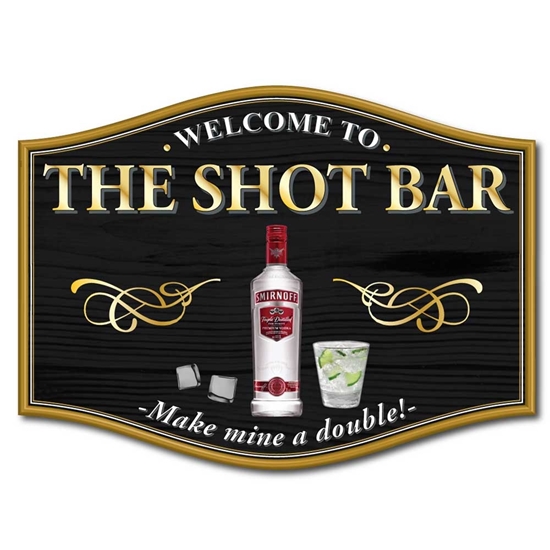Handy Advice For Choosing Pub Signs
Handy Advice For Choosing Pub Signs
Blog Article
What Are The Differences Between Bar Signs Based On Their Location?
The location of bar signposts is vital. They are designed, placed, and purposed to be effective in specific areas. Below is a breakdown of the different bar signs, based on their location. Signs for the exterior
Purpose: To establish the bar and draw patrons.
Features: Eye-catching, large features, usually illuminated to improve the night's visibility.
Materials: Weather-resistant, durable materials such as neon and vinyl.
At the entrance, signs say Bar's name and logo, marquee and so on.
2. Entrance Signs
Welcoming clients and giving them initial information.
Features: Clear, inviting and frequently with branding elements.
Materials Signs made of wood, metal signs and illuminated signs.
Examples: "Welcome' signs, schedules of operation or other announcements.
3. Wall signage for the interior
The purpose of this is to enhance the decoration, offer information and to create an atmosphere.
Features: Available in a variety of sizes and styles that match your interior decor.
Materials: Wood, metal, chalkboard, acrylic.
Examples: Menu boards, inspirational quotes and thematic decor signs.
4. The Bar's Signs
Purpose: To highlight key elements such as the bar's name, its signature drinks or specials.
Features: A prominent and well lit focal point.
Materials: LED, neon Digital display, chalkboard or any other materials.
Example: Digital menus, digital drink specials boards, and name signs for bars.
5. Ceiling and Hanging signs
The purpose is to enhance the decor or provide instructions from above.
Features: Suspended from the ceiling. It is visible from all angles.
Materials: Lightweight materials such as foam board, metal, or acrylic.
Examples: Hanging decorative signage with themed props, as well as directions Arrows.
6. Tabletop Signs
Provide specific information to patrons at the table.
Features: Small fonts that are easily read from a distance.
Materials: Wood, acrylic and laminated paper.
Examples: Menus for Drinks, Table Numbers, Promotional Card, and QR Code Stands.
7. Signs for Restrooms
Objective: To clearly mark the location of restrooms.
Characteristics: Highly visible with clear and often clear symbols as well as the text.
Materials: Metal, plastic, wood.
For example, male and women's restroom signs.
8. Directional Signs
The purpose of this sign is to guide patrons to various areas of the bar.
Highlights clear labels and arrows easily read.
Materials: Metal, acrylic, wood.
For instance, signs that point to restrooms or exits.
9. Window Signs
The purpose is to make the bar more visible and also inform passers-by.
Features: Easily visible from outside, usually including lighting.
Materials: Vinyl decals, neon, LED.
Examples include: promotional signs such as operating hours, promotional signs, and event announcements.
10. Signs for Promotions and Events
Use: To notify patrons about special occasions, seasonal promotions or other offers.
Highlights: Always eye-catching and short-lived.
Materials: Vinyl, foamboard, chalkboard.
Examples include event posters, promotion banners, and chalkboard-themed specials.
Location-Specific considerations
Visibility
Exterior and Entrance Signs: Should be visible from afar to attract customers.
Interior and Behind-the-Bar Signs They should be strategically placed for maximum impact and readability.
Durability
Outdoor Signs: Use weather-resistant materials to withstand outdoor conditions.
Interior Signs can use different materials because they are not exposed to the elements.
Aesthetic Integrative Integration
Signs with decorative designs and behind the bar signage should match your interior design theme.
Informational and Directional Signs: They should be practical, yet blend into the décor.
Functionality
Directional and restroom signs: They must be easy to read and clear to allow patrons to navigate the space easily.
Signs for the event and promoter should be temporary or changeable to reflect the latest offers.
Lighting
Signs for windows and exteriors illuminated to increase visibility at night.
Interior and Behind-the-Bar signs can use lighting to highlight specific areas or to create ambiance.
By adjusting bar signs' design, placement and materials to their precise locations bar owners can improve the functional and aesthetic appeal of the establishment, thereby creating an environment that is warm and harmonious. See the top rated his explanation for man cave signs for website info including personalised cocktail bar sign, small pub signs, pub signs for home bars, bar signs for home, the staying inn sign, garden bar sign personalised, personalised home pub sign, large personalised bar signs, home pub signs, personalised garden bar signs and more.
What Are The Differences Between Bar Signs In Terms Of Durability?
Bar signs can be durable dependent on various factors, including the material, construction, site and purpose of use. Here are some bar signs that vary in their durability. Material
Metal: Signs made of metals like steel, aluminum or any other metal are durable. They can also be used outdoors.
Wood: Signage made of solid wood is long-lasting, but it requires regular maintenance to keep it from rotting and bending.
Acrylic: Acrylic signs can be used outdoors and are durable.
Neon/LED: Neon signs can be delicate and prone to damage, whereas LED signs last longer and are energy-efficient.
2. Weather Resistance
Outdoor Signs for the outdoors. The materials and the coatings used should be resistant to fade, corrosion and water damage.
Indoor Signs: Despite not being subject to extreme weather conditions, indoor signage still must be able to withstand extreme temperatures, humidity and wear.
3. Construction
Solid Construction: Signs made of sturdy frames, corners that are reinforced, and durable installation equipment are more robust.
Sealed Components Signs that have sealed electronic components (for illuminated sign) are less vulnerable to water damage.
4. Maintenance Requirements
Low maintenance: Bar owners will find it easier to have signs that require periodic cleaning or only minimal maintenance.
Signs that require high maintenance: Signs with intricate designs or delicate materials could be a time-consuming and expensive to maintain.
5. Location
Indoor signs are generally more resistant to environmental dangers. They might also be less durable than outdoor signs.
Outdoor Signs: Outdoor signage must be durable to withstand sunlight, rain, winds, and temperature changes.
6. Impact Resistance
Signs that are designed to be used in areas of high traffic or in which they are subject to damage (e.g. bars with a lot of people) should be made of durable materials that resist scratching or dents.
Protected surfaces: Signs that have protective coatings and laminates are less susceptible to damage caused through vandalism, spills or scratches.
7. Longevity
Durability: Long-lasting signs can be used for many years with no significant degrading which results in a significant ROI.
For short-term use: Signs made for events and promotions that are temporary might not last as long or last as long-lasting signage.
8. Lighting
Lighting Components. Illuminated signs with LED or neon lighting should make use of high-quality, durable components that will last.
9. Environmental Impact
Signs made using sustainable and recycled materials can reduce the environmental impact. They provide a long-lasting quality and durability.
10. Customization
Custom Options: Signs with custom options are available with different levels of durability, based on the materials used and the production method employed.
Durability The benefits of durability
Cost-Effectiveness. Durable signs are less likely to need replacement or regular maintenance.
Brand Image High-quality, durable signs reflect positively the brand image of your bar and professional.
Customer Satisfaction - Signs in good condition enhance the overall ambience of the bar and contribute to the satisfaction of customers.
In assessing factors such as the material, construction and site needs Bar owners are able to choose a signage solution that will provide the durability needed to stand up to the elements. They can also add value in the long run. See the top hanging bar sign advice for site info including a bar sign, personalised cocktail sign, outdoor home bar signs, personalised home pub sign, bar sign hanging, garden bar sign personalised, pub signs personalised, outdoor personalised bar sign, design your own bar sign, personalised metal bar signs and more.
What Is The Difference Between Bar Signs From Regulations?
The bar sign is subjected to various regulations, which are imposed by local as well as federal and state authorities to ensure aesthetic standards, public health and compliance with zoning laws, and to ensure public welfare. What are the regulations that are applicable to bar signs? Size and Placement Regulations
Zoning Laws: Regulations specify the locations where signs are allowed to be posted as well as their size, height, and distance from roads, property lines, or neighboring buildings.
Historic Districts: Signs can be limited to preserve the historical nature of specific districts. This could include limitations on design, size and materials.
2. Illumination Restrictions
Light Pollution Regulations can limit the brightness and color of illuminated signs to protect the atmosphere at night and limit light pollution.
Safety: Signs should not create glare or other light sources that can be dangerous to drivers or pedestrians. This is particularly true near roads.
3. Signage Content
Alcohol Advertising: Alcohol advertisements are banned in certain states. They ban images or content that may be attractive to minors, or promote excessive drinking.
Health Warnings: Some laws might require that signage contain warnings on the dangers of alcohol or smoking cigarettes.
4. Historic Preservation Regulations
Architectural Compatibility. Signs in historic districts must be compatible with the architectural style and the character of the area. Often preservation committees or boards must approve the signs.
Materials and Design Limitations may be applied to the materials, design, and color schemes of signs to maintain their historical integrity.
5. Sign Permitting Process
Permits are required: Owners of bars need permits to install or modify signage. This could involve submitting drawings, paying for fees, as well as obtaining approvals from local authorities.
Code compliance: Signs must comply with the construction codes, fire safety standards, and accessibility guidelines to ensure the safety of the public.
6. Sign Removal, Maintenance and Repair
Maintenance Requirements. Bar owners are held to a responsibility to keep the signs in good condition by ensuring they are free from hazards and conforming with regulations.
Signs abandoned by the owner: Laws can govern the removal of abandoned or dilapidated signs to prevent blight and maintain the beauty of the location.
7. Digital Signage Regulations
Content Restrictions There are laws in place that govern the content of digital signs. They could prohibit certain types of content, like pictures that are offensive or lights that flash.
Limitations to Operation: Regulations could restrict the intensity, brightness, or frequency of change in digital signs to limit visual clutter and distractions.
8. Enforcement and Penalties
Inspections are carried out by local authorities to verify the compliance of signage laws. Infractions can be punished.
Penalties: Penalties if you do not follow the rules may include citations or fines, orders to remove or modify signs, or legal actions.
9. Signing Process
Bar Owners can request an exemption to permit them to break from the standard regulations for signs. The bar owner must justify their request and prove that it will not have negative effects on public safety.
Public input: Changes could require public meetings, or input from local community, property owners who live in close proximity, or business groups.
10. Community Input and Engagement
Public Consultation. Some jurisdictions permit residents to take part in the design of sign regulations through public meetings and surveys.
Community Benefits: Sign regulations may include provisions for promoting local businesses or revitalize the neighborhood.
Knowing and adhering to the regulations for signage can help bar owners ensure that their signage contribute positively to surrounding communities, comply with the legal requirements and reduce the possibility of fines and penalties. See the top rated bar hanging sign url for website tips including sign for garden bar, personalised pub, make your own bar sign, sign for garden bar, garden bar signs, pub signs for garden, personalised signs for home bar, home made bar sign, personalised outdoor pub signs, bespoke bar signs and more.